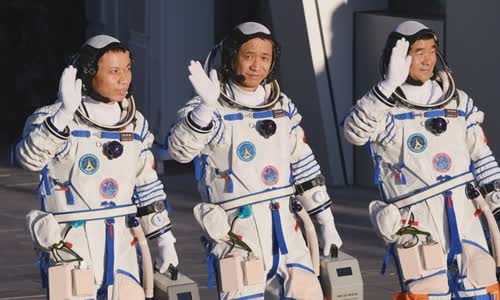China strongly invested in aerospace programs in recent years, but they still have a long distance compared to the US.
The ambition of Chinese space began to cause attention after the country last week to successfully put three astronauts into orbit to complete their work on their first spacecraft station.

Photo: AFP.
The Shenzhou Spacecraft transported three Chinese astronauts took off on June 17 from the Security Running Center on Gobi desert.
Three Chinese astronauts raised their hands before boarding the Shenzhou to arrive at Thien Cung Space Station on June 17.
This flight into the universe has the first crew conducted by China for nearly 5 years and is the latest development in a space program that is constantly creating rapid progress, turning Beijing
China is shortening the distance from the US, the country has taken astronauts into the trajectory for the first time last year since NASA retired the entire shuttle in 2011. This makes the US to depend
The missions of astronauts are testing devices and technologies not only new to China's space program but also with the whole world.
The basic foundation for the ambition to conquer the space of China is a series of Chinh Chinh boosters and other missiles.
These missiles are also used to bring almost all China's existing satellites to orbit.
In total, Beijing has implemented 340 universal launches as by 2020 and in the past decade, their launchers become most busy in the world.
At the end of this year, more than 40 other launchers were planned to implement, marking a record for China, according to green books 2020 on Chinese technology and aerospace activities.
All these steps help China significantly rise in the space race with the United States.
They will take people on the moon.
However, the ambition is still out of reaching China.
Truong Chinh 5 can match the missiles of Europe or Russia but cannot keep up with the Falcon Heavy American missile model with a load of up to 63.8 tons.
Two super-load missiles used in moon mission and other important space tasks are developed by Chinese Aerospace Science and Technology Corporation.
Strategic and International Research Institute (CSIS) in a report last month to assess China's actual route after other space powers.
Although China has made great strides in space, the overall release capacity and their rocket load still lag behind the older cosmic powers like the United States, the report said.
China also lagged behind the US on satellites.
In total, the US launched 916 spacecraft, including the ship to bring satellite to space, last year, compared to China's 85.
The Chinese government has invested heavily on the space program and they are now the world's second most spending on this ambition, but still far away from America.
Hong Kong military commentator said average that the distance between Washington and Beijing is still significant and though China is achieving rapid progress, they can still take years to catch up with the US.
This is part of the overall strategic competition between them, Tong said.



 Robbie Dyches
Robbie Dyches







